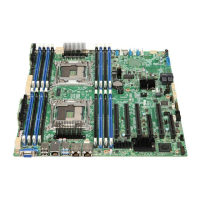Intel® Server Board S2600CW Family TPS System Security
Revision 2.4
Table 8. Setup Utility – Security Configuration Screen Fields
Activated
Enabled and
Deactivated
Disabled and
Activated
Disabled and
Deactivated
Shows the current TPM device
state.
A disabled TPM device will not
execute commands that use TPM
functions and TPM security
operations will not be available.
An enabled and deactivated TPM is
in the same state as a disabled
TPM except setting of TPM
ownership is allowed if not present
already.
An enabled and activated TPM
executes all commands that use
TPM functions and TPM security
operations will be available.
Administrative
Control
Turn On
Turn Off
Clear Ownership
[No Operation] – No changes to the
current state.
[Turn On] – Enables and activates
TPM.
[Turn Off] – Disables and
deactivates TPM.
[Clear Ownership] – Removes the
TPM ownership authentication and
returns the TPM to a factory default
state.
Note: The BIOS setting returns to
[No Operation] on every boot cycle
by default.
4.2 BIOS Password Protection
The BIOS uses passwords to prevent unauthorized tampering with the server setup.
Passwords can restrict entry to the BIOS Setup, restrict use of the Boot Popup menu, and
suppress automatic USB device reordering.
There is also an option to require a Power On password entry in order to boot the system. If
the Power On Password function is enabled in Setup, the BIOS will halt early in POST to
request a password before continuing POST.
Both Administrator and User passwords are supported by the BIOS. An Administrator
password must be installed in order to set the User password. The maximum length of a
password is 14 characters. A password can have alphanumeric (a-z, A-Z, 0-9) characters and it
is case sensitive. Certain special characters are also allowed, from the following set:
! @ # $ % ^ & * ( ) - _ + = ?

